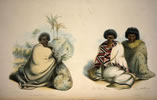The two decades after the signing of the Treaty of Waitangi were marked more by cooperation between Māori and non-Māori than by conflict. Organised immigration began in 1840 and soon created a scattering of European settlements around the coast. At first these settlements were economically dependent on their Māori neighbours, who provided most of the food for the growing towns while retaining control of their own tribal territories. At a time when the European farmers at Port Nicholson (Wellington) did not own a single plough, the Taranaki people at Waitara had 35 ploughs, 40 carts and a fleet of sailing boats to transport their produce to market.
There were ugly exceptions to the generally good relations of this period, often triggered by questionable land deals. After the Wairau incident of 1843, one government official said that the settlers ‘talk of nothing else but the extermination of the poor Maoris.’1 Two years later, British troops arrived to suppress unrest in the Bay of Islands.
Māori resist land sales
As the number of colonists, mostly from Britain, increased, the Māori population declined because of the impact of introduced diseases. By 1858, non-Māori outnumbered Māori. The newly arrived settlers were eager to acquire Māori land and often viewed its owners with contempt. In the 1840s, an English immigration agent described the Māori of the day as a ‘dirty, squalid, unimprovable and intolerably ugly generation … the sooner they were all transplanted to the happy hunting-grounds, the better it would be for universal humanity’.2
During the 1850s, some tribes sold land willingly and continued trading with Europeans but other Māori began to fear the loss of their customs, territory and mana. The Kīngitanga (Māori King movement) arose to resist large-scale land sales. Its followers regarded their king as equivalent to, but not a challenge to, the queen in England.
New Zealand Wars
This uneasy truce disintegrated in the late 1850s and war broke out in Taranaki in early 1860, then elsewhere in the North Island. Māori fought alongside, as well as against, Pākehā, and warm friendships developed between the British and settler troops and their ‘friendly Māori’ allies. The courage and skill of the ‘rebel’ Māori also aroused the admiration of their opponents. However the New Zealand Wars of the 1860s represented, overall, the lowest point in the history of New Zealand’s race relations. More than 2,000 Māori and more than 500 Europeans were killed, and several million hectares of land was confiscated in Waikato, Taranaki and Bay of Plenty. These losses crippled large sections of the Māori people and created grievances that lasted more than a century.
South African War
After the land wars large areas of the North Island, in particular the King Country and the Urewera, remained under Māori control, but most Māori accepted the authority of the settler-dominated government. When the war in South Africa (1899–1902) broke out, some Māori tried to enlist in the New Zealand contingents. The British government declared that indigenous troops should not be deployed against Europeans and Māori were officially barred from enlisting, although some did so under European names.
First World War
During the First World War, the New Zealand government actively enlisted Māori for the war effort. The Māori response followed the geographical pattern of the New Zealand Wars. ‘Rebel’ tribes such as Waikato opposed conscription, but tribes that had supported the government in the land wars signed up willingly. A Māori Contingent suffered many casualties at Gallipoli and was re-formed as a Pioneer Battalion to undertake labouring tasks on the Western Front.
Mana wahine
Women as well as men felt the change that the Second World War brought to relations between the races. A shortage of manpower allowed women into occupations and roles formerly closed to them. On the East Coast, elderly Māori women stood to speak on marae. Younger Māori women moved to cities and worked in factories alongside Pākehā women. Often the two peoples were in close contact for the first time.
Second World War
Māori gained much greater respect from Pākehā during the Second World War, when 28 (Māori) Battalion earned a reputation as one of the most courageous and effective Allied infantry units. Individuals such as Te Moananui-a-Kiwa Ngārimu VC and Colonel Pita Awatere were regarded as heroes by all New Zealanders, and race relations improved significantly. After the war, Māori veterans successfully challenged official discrimination in the provision of welfare benefits, rehabilitation and housing.
In subsequent foreign wars and peace-keeping missions, Māori troops have continued to distinguish themselves at all levels of command, from Corporal Willie Apiata, who won a VC in Afghanistan in 2004, to Lieutenant-General Jerry Mateparae, who was Chief of the Defence Force and then governor-general.



